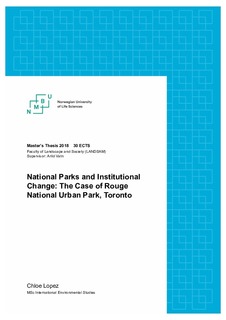| dc.description.abstract | Rouge National Urban Park has been described as "the first of its kind" in Canada. Its proximity to the largest urban centre in the country, and the challenges represented by this, makes it an interesting case study in environmental governance. The aim of this thesis is to analyze the institutional change represented by the transition in the status and management of the Rouge from a local park to a national park.
This thesis aims to answer the questions:
1. What were the main characteristics of the decision-making process that resulted in the establishment of Rouge National Urban Park?
2. How did the regime change after the transition to Parks Canada?
3. What are the effects of the new regime on the actions of economic and civil society
actors?
4. What are the expected impacts of the new regime on the resources in the park and
how they will be used in the future?
To analyze the institutional change in resource management exemplified by the establishment of Rouge National Urban Park, this thesis will use the Environmental Governance Framework proposed by Vatn (2015). Under this framework, it will examine the different actors involved in the transition to the new national park regime, as well as their preferences, interests, and interactions. National parks are seen as an institution, which has some basis on internationally- accepted definitions of protected areas under the International Union for the Conservation of Nature (IUCN) Category II.
To analyze the results of the new regime, Underdal (2002)’s framework on Regime Effectiveness will be used. The change in the park’s legislation and operations are seen as the output of the decision-making process, while its effect on economic and civil society actors’ behaviour is seen as its outcome. Finally, the long-term effect of the decision-making process and its output on the resource being governed is seen as the impact. Per date, it has only been possible to indicate what is expected, Rouge National Urban Park is relatively new.
This particular case study is examined from different actors’ perspectives. To do so, qualitative research methods such as interviews and literature reviews have been used. An array of primary and secondary sources, such as government documents, public documents, and news articles, have also been chosen to provide a balanced and diverse overview of the issue.
It is worth noting that, as exemplified in this case, politics has as much to do with conservation as does governance. This is due to the fact that decision-making is a political process, and the resulting legislation frames the way resources are managed. While it remains to be seen what the long-term impact of these decisions will be on the natural and cultural resources in the park, this thesis contends that the park lands will be better administered under federal management. Not only will the Rouge be protected in perpetuity, but once the land transfers have been finalized, an important natural ecological corridor will be formalized and preserved. Having these lands unified and maintained by an agency with the mandate and the means to do so will be beneficial, especially due to the park’s location within developed areas. At the same time, it will be vital to continue partnerships with important stakeholders such as farming communities, First Nations groups, and local conservationists.
Maintaining the balance between nature and culture in an urban setting means that the Rouge represents a new model of park management in Canada. Lessons learned from its experience could be applied in similar cases around the world. | nb_NO |

